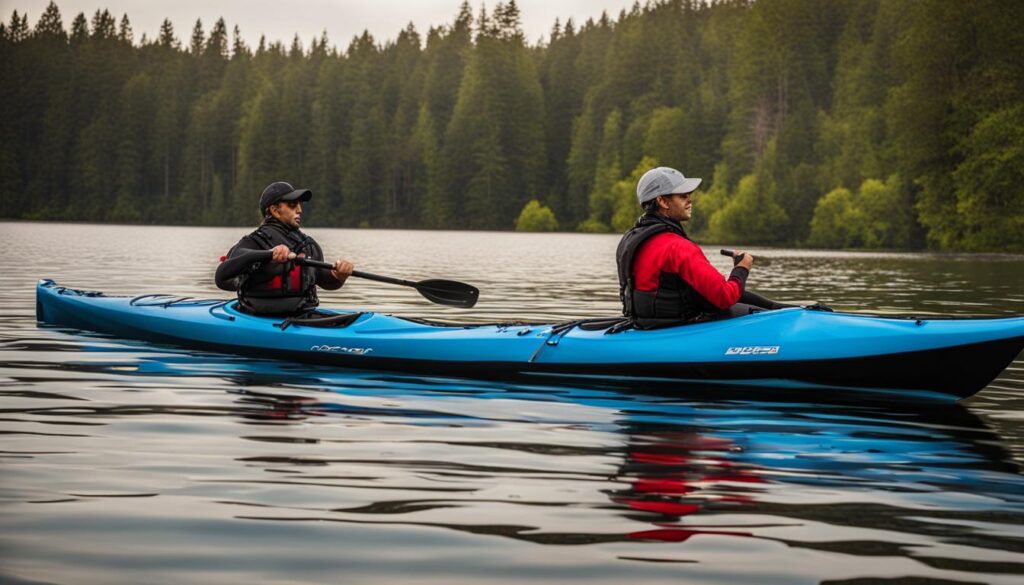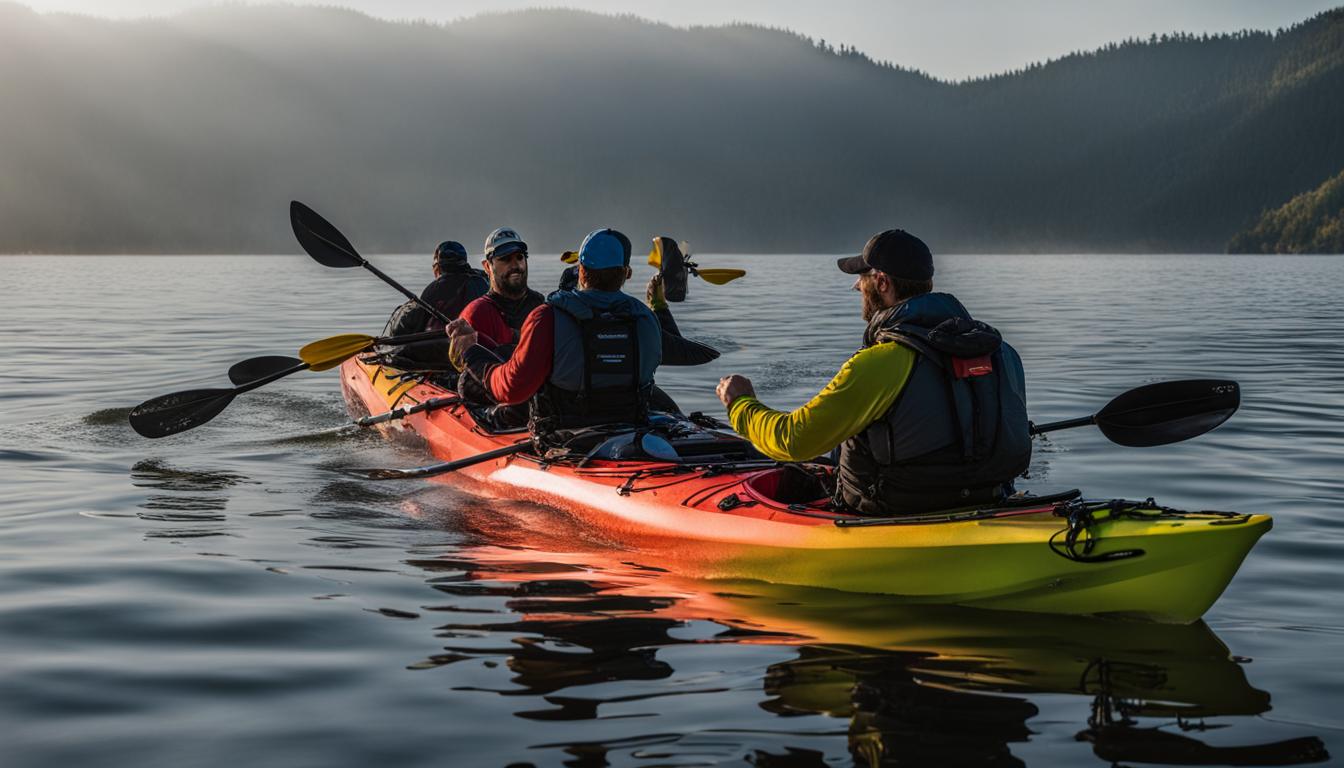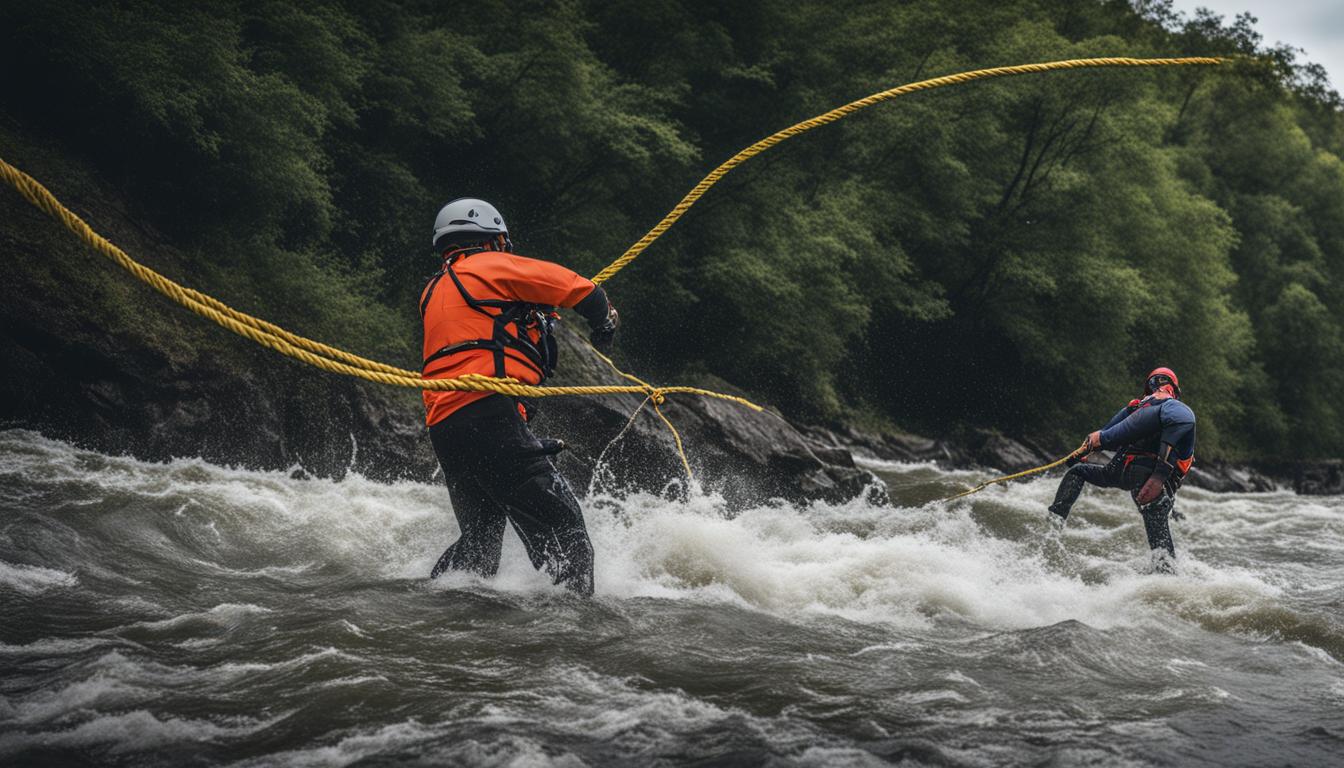Making your kayak seat more comfortable is essential for a great paddling experience. By following these tips and tricks, you can maximize comfort in your kayak seating. Strategies for kayak seat comfort optimization include adding cushions or padding, choosing the right materials, maximizing lumbar support, and opting for high-back kayak seats. These methods will enhance the ergonomics of your kayak seat and provide the comfort you need for long-duration paddling.
Key Takeaways:
- Adding cushions or padding can significantly improve comfort in kayak seating.
- Choosing the right materials for your kayak seat can enhance the overall comfort and durability.
- Maximizing lumbar support is crucial for a comfortable paddling experience.
- Opting for high-back kayak seats can provide additional support for your lower back, neck, and shoulders.
- Considering these tips and tricks will help you maintain a comfortable and ergonomic kayak seat.
Maximizing comfort in kayak seating is essential for an enjoyable paddling experience. By following the tips and tricks mentioned in this article, such as padding your seat with memory foam, covering your seat with gel pads, choosing the right material, maximizing lumbar support, and opting for high-back kayak seats, you can enhance the comfort and ergonomics of your kayak seat. Additionally, considering comfortable seating designs, customizable options, seat modifications, and proper maintenance will ensure long-lasting comfort in your kayak seating. Happy paddling!
Pad it with memory foam seat cushion
Adding a memory foam seat cushion to your kayak seat is a simple and effective way to enhance comfort. The memory foam material molds to your body, providing customized support and reducing pressure points. This cushioning layer creates a soft and plush surface against your body, ensuring a more comfortable paddling experience.
You can choose from various materials for the memory foam seat cushion. Neoprene foam, known for its durability and water resistance, is a popular choice. Closed-cell foam is another option, offering excellent support and cushioning. For those who prefer a slightly bouncier feel, air pads provide additional shock absorption, helping to absorb bumps and vibrations on the water.
When selecting a memory foam seat cushion, it is essential to choose a material that is waterproof and UV-resistant. This ensures the cushion remains in good condition despite exposure to water and sunlight. Additionally, consider a cushion cover made from marine-grade vinyl for added durability and longevity.
Comparison of Memory Foam Seat Cushion Materials
| Material | Benefits |
|---|---|
| Neoprene foam | Durable, water-resistant |
| Closed-cell foam | Excellent support, cushioning |
| Air pads | Shock absorption, bouncier feel |
Table: Comparison of Memory Foam Seat Cushion Materials
By padding your kayak seat with a memory foam cushion, you can significantly improve your comfort while paddling. The customized support and cushioning provided by memory foam, along with the choice of materials such as neoprene foam, closed-cell foam, or air pads, will ensure a more enjoyable and relaxing experience on the water.
Cover your seats with gel pads or thin minicell foams
To further improve the comfort of your kayak seat, consider covering it with gel pads or thin minicell foams. These materials provide excellent support and can significantly reduce fatigue during long paddles. Gel pads are designed to conform to the shape of your body, offering customized support and enhancing overall comfort. They are also waterproof and UV-resistant, ensuring durability even in harsh conditions.
Thin minicell foams are another popular option for kayak seat coverings. These foams are lightweight yet offer excellent cushioning, providing a soft and comfortable surface to sit on. They are also waterproof and UV-resistant, keeping your seat protected from moisture and sun damage. By adding gel pads or thin minicell foams to your kayak seat, you can create a more supportive and enjoyable paddling experience.
When choosing gel pads or thin minicell foams, it is important to consider the dimensions and shape of your kayak seat. Ensure that the pads or foams are compatible with your seat and can be securely attached without compromising stability. Additionally, make sure they are easy to clean and maintain, as proper care will prolong their lifespan. By investing in these seat coverings, you can elevate your comfort level and make every kayak trip more enjoyable.
| Gel Pads | Thin Minicell Foams |
|---|---|
| Conforms to body shape | Lightweight and cushioning |
| Waterproof | Waterproof |
| UV-resistant | UV-resistant |
| Provides customized support | Soft and comfortable surface |
| Easy to clean and maintain |
By covering your kayak seat with gel pads or thin minicell foams, you can add an extra layer of comfort and support to your paddling experience. These materials are designed to enhance the ergonomics of your seat, reducing fatigue and ensuring enjoyable hours on the water. Whether you choose gel pads that conform to your body shape or thin minicell foams that provide cushioning, both options offer waterproof and UV-resistant qualities for long-lasting durability. Upgrade your kayak seat with these coverings and enjoy the benefits of a more comfortable and enjoyable paddling journey.
Choose the Right Material for the Surface of Your Seat
When it comes to maximizing the comfort of your kayak seat, selecting the right material for the surface is crucial. The material you choose not only affects your comfort but also contributes to the overall durability and functionality of your seat.
One option for the seat surface is breathable mesh. This fabric allows for proper air circulation, keeping you cool and preventing sweat buildup during long paddles. The open, porous nature of breathable mesh also aids in temperature regulation, ensuring you stay comfortable in varying weather conditions. Additionally, this material is sweat-wicking, meaning it helps to draw moisture away from your body, keeping you dry and comfortable throughout your excursion.
Another suitable material for kayak seat surfaces is neoprene fabric. Neoprene is known for its durability and resistance to wear and tear. This fabric is also soft and smooth to the touch, providing a comfortable seating experience. Additionally, neoprene is abrasive-free, preventing any chafing or discomfort during your paddling trips.
By opting for a seat surface made of breathable mesh or neoprene fabric, you can significantly improve your paddling comfort and enjoy longer hours on the water without any discomfort or irritation.

Table: Comparison of Breathable Mesh and Neoprene Fabric
| Material | Breathable Mesh | Neoprene Fabric |
|---|---|---|
| Temperature Regulation | Allows for proper air circulation, keeping you cool | Retains body heat, keeping you warm in colder conditions |
| Sweat-Wicking | Draws moisture away from the body, keeping you dry | May cause sweat accumulation in hotter conditions |
| Durability | May be less durable compared to neoprene | Highly durable and resistant to wear and tear |
| Comfort | Provides a soft and breathable seating surface | Offers a smooth and comfortable seating experience |
| Resistance to Chafing | Minimizes the risk of chafing and irritation | Abrasive-free, ensuring no discomfort or chafing |
Maximize Lumbar Support
When it comes to ensuring maximum comfort in your kayak seat, one key element to focus on is lumbar support. Proper lumbar support can alleviate lower back strain and discomfort during long paddling sessions. Whether your kayak seat already has built-in lumbar support or not, there are ways to maximize this essential feature to enhance your overall seating experience.
The Importance of Lumbar Support
Lumbar support is crucial for maintaining proper posture and reducing the risk of lower back injuries while paddling. It helps align your spine, supporting the natural curve of your lower back. Without adequate lumbar support, you may experience discomfort, fatigue, and even pain during and after your kayaking adventures.
Simple Ways to Maximize Lumbar Support
There are a few simple methods you can try to maximize lumbar support in your kayak seat. One technique is to sit in your kayak seat and place a rolled-up towel or cushion in the lower back area. This will help you determine if additional support is needed and where it should be placed.
“Proper lumbar support can alleviate lower back strain and discomfort during long paddling sessions.”
If you find that your current seat lacks sufficient lumbar support, you can consider adding aftermarket lumbar support cushions or pads designed specifically for kayaking. These accessories are usually adjustable, allowing you to customize the level of support to your preference.
Remember, the goal is to have proper lumbar support without restricting your movement. It’s important to find a balance that allows for unrestricted movement in the hip and shoulder areas, while still providing the necessary support to your lower back.
Opt for high-back kayak seats
If you’re looking to enhance your comfort and reduce fatigue during long paddles, choosing high-back kayak seats is a smart choice. These seats provide additional lumbar support, which helps reduce strain on your lower back and allows for improved posture. With the extra support, you’ll experience reduced fatigue and discomfort, enabling you to paddle for longer periods without feeling tired.
High-back kayak seats also provide excellent neck and shoulder support, ensuring that these sensitive areas are well-cushioned. This feature is particularly beneficial for those who spend extended periods on the water and need proper support for their upper body. By opting for high-back kayak seats, you can paddle in comfort and enjoy your time on the water without worrying about discomfort or tension in these areas.
In addition to the physical benefits, high-back kayak seats also offer added peace of mind. With their ergonomic design and sturdy construction, these seats provide a secure and stable seating position, allowing you to focus on your paddling technique and enjoy your surroundings. So, if you’re looking to upgrade your kayak seating setup, consider opting for high-back kayak seats to enjoy the benefits of additional lumbar support, reduced fatigue, and enhanced neck and shoulder comfort.

Table: Comparison of Kayak Seat Types
| Standard Seats | High-Back Seats | |
|---|---|---|
| Lumbar Support | Limited | Excellent |
| Neck and Shoulder Support | Minimal | Highly supportive |
| Overall Comfort | Fair | Superior |
| Fatigue Reduction | Limited | Significant |
| Seat Stability | Standard | Enhanced |
Table: This table provides a comparison of standard kayak seats and high-back kayak seats. It highlights the key differences in lumbar support, neck and shoulder support, overall comfort, fatigue reduction, and seat stability. High-back seats outperform standard seats in all these aspects, making them a superior choice for maximizing comfort during kayaking.
Conclusion
Maximizing comfort in kayak seating is essential for an enjoyable paddling experience. By following the tips and tricks mentioned in this article, you can enhance the comfort and ergonomics of your kayak seat.
One of the key factors in achieving comfortable kayak seating is considering different seating designs. Look for seats that offer cushioning and support in the right places, ensuring a better paddling experience.
Another aspect to consider is customizable kayak seating options. Adjustable seats and backrests allow you to find the perfect fit for your body, ensuring maximum comfort throughout your entire journey.
If you find that your current kayak seat isn’t providing the desired comfort, don’t worry. You can explore kayak seat modifications to meet your specific needs. Whether it’s adding extra padding, adjusting straps, or even installing aftermarket accessories, there are plenty of options available.
Finally, maintaining your kayak seat’s comfort over time is essential. Regularly clean and inspect your seat, ensuring it remains in good condition. This will help prevent any discomfort or issues that may arise from wear and tear.
Remember, comfortable kayak seating designs, customizable options, seat modifications, and proper maintenance are all key to maintaining a comfortable and enjoyable paddling experience. So, make the necessary adjustments and modifications to achieve the perfect seat for your adventures. Happy paddling!
FAQ
What can I do to make my kayak seat more comfortable?
There are several strategies you can try to optimize the comfort of your kayak seat. These include adding cushions or padding, selecting the right materials, maximizing lumbar support, and opting for high-back kayak seats.
What materials can I use to add cushioning to my kayak seat?
You can choose from materials such as memory foam, neoprene foam, closed-cell foam, or air pads for cushioning your kayak seat. These materials provide a soft and plush layer against your body or extra bounce to absorb bumps and vibrations.
Can I cover my kayak seat with gel pads or thin minicell foams?
Yes, covering your seats with gel pads or thin minicell foams is a great way to add extra comfort. These materials conform to the shape of your body, providing support and reducing fatigue during long paddles.
What materials should I choose for the surface of my kayak seat?
It is important to choose materials like breathable mesh or neoprene that can regulate temperature and wick away sweat. You should also select a material that is not abrasive and does not cause chafing, ensuring a comfortable and irritation-free seating experience.
How can I maximize lumbar support in my kayak seat?
Many modern kayak seats come with built-in lumbar support, but you can also add this feature to existing seats. You can test the level of lumbar support by sitting in your kayak seat with a rolled-up towel or cushion between your back and the seat to determine if additional support is needed.
Are high-back kayak seats a good option for extra support?
Yes, high-back kayak seats provide additional lumbar support and help reduce fatigue during long paddles. They offer better support for your lower back, neck, and shoulders, allowing you to paddle for longer periods without discomfort.
What else can I consider for comfortable kayak seating?
In addition to the tips and tricks mentioned, you can also consider comfortable seating designs, customizable options, seat modifications, and proper maintenance to ensure long-lasting comfort in your kayak seating.





